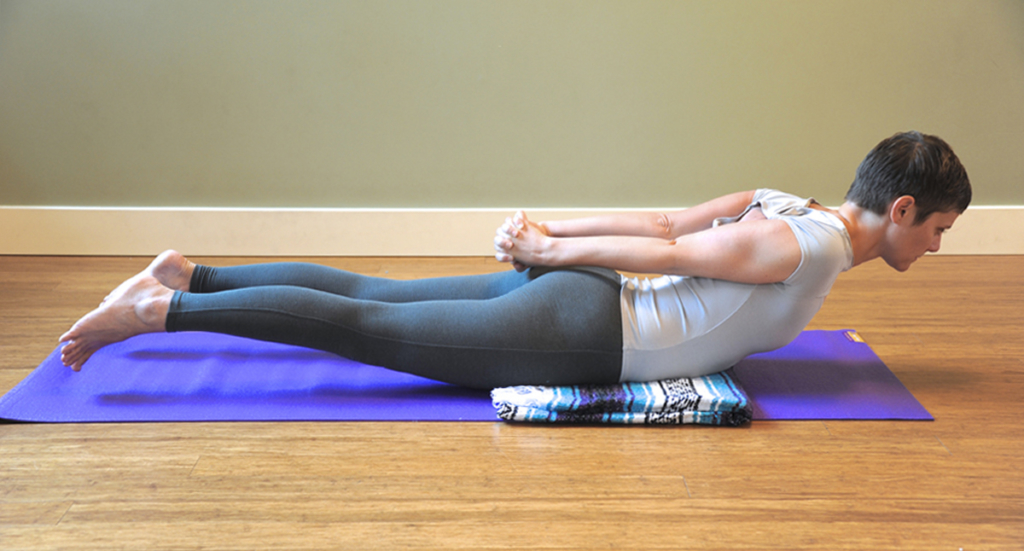
You won’t see them often on Instagram. There are so many other backbends that look way more impressive. In fact, they may barely register as backbends when you look at the outer form. Indeed, they are called “baby” backbends, suggesting lesser poses that are reserved for people who can’t do the “real” backbends. And yet, after 38 years of yoga practice, I’ve developed new appreciation for these power-packed poses.
In 2016, I had my first bone density scan. While I had no reason to think my bones might be at risk—my mother touted her strong bones well into her 80s—my doctor recommended it as a matter of course. Much to my surprise and disappointment, the results showed osteopenia in my lumbar spine. My doctor recommended bone-building drugs, but was open to my desire to try a more targeted calcium supplement and to change my exercise program. In late 2019, I had another bone scan. The second scan showed significant improvement.
I can’t attribute my improvement to just one thing. I’ve faithfully taken daily calcium and have brought my vitamin D3 up to a healthy level. (My D3 levels were quite low at the time of my first bone scan.) In addition, I started weekly strength training 18 months ago. And I’ve begun practicing a whole lot more baby backbends.
The Core is Not Just the Abs
Most of the time when we think of stabilizing the core, abdominal strengthening comes to mind. While weak abdominals do contribute to back pain and postural problems, abdominal strengthening is only half of the equation. Weak back muscles contribute equally to these issues.
We spend a whole lot of our time sitting. When we sit and hunch over a device, every joint is in a flexed position—the spine, the shoulders, the hips, the knees and the ankles. This can cause the flexors—including the abdominal muscles—to shorten, and the extensors—including the back muscles—to become slack. As the flexors shorten, we become a whole lot more likely to assume a flexed posture even when we are not sitting. (FYI: in terms of the spine, “flexion” means forward bending and “extension” means backbending.)
Over time, gravity conspires with the force of habit to cause the spine to become fixed in a forward-flexed position. The spinal extensors, the muscles that help us maintain an upright spine, continue to weaken and can no longer do their job of keeping the spine vertical.
The solution: strengthen the spinal extensors, specifically the erector spinae. The name tells you all you need to know: when they contract, they keep the spine erect. These muscles not only help you maintain upright posture; the pressure of these muscles squeezing in on the spine helps build and strengthen the vertebrae.
Baby Backbends for Strong Bones and Upright Posture
In my experience, the yoga poses that are most supportive of strengthening the spinal extensors are the baby backbends. These powerful poses are mostly practiced from a prone position. They include poses such as Salabhasana (Locust Pose), Bhujangasana (Cobra Pose) and Ardha Bhujangasana (Half Cobra Pose). Setu Bandha Sarvangasana (Bridge Pose) can also reside in the baby backbend category, even though it’s initiated from a supine position. Most of all, baby backbends are poses that employ the spinal extensors—either exclusively or with some support from the limbs—to gently but powerfully extend the spine.
My number one pick for spine-strengthening, posture-supporting baby backbends are the many variations of Salabhasana. What makes these poses especially powerful is that they employ the back muscles exclusively to engage the spinal extensors. In Cobra Pose, Bridge Pose and the other backbending yoga poses, the arms and legs support spinal extension, sometimes so much so that the back muscles largely disengage.
How to Practice Baby Backbends
- Gather your props: a yoga mat and a folded blanket.
- Lie face down on the mat with the folded blanket under your hipbones.
- Extend your arms alongside your body. Then clasp your fingers behind you, rolling the shoulders up and away from the floor. Stretch your hands back behind you.
- Ground your hips, legs and feet, and lift your chest, shoulders and head off the floor. Avoid throwing your head back. Instead, keep the back of your neck long, so that your head and neck follow the trajectory of your thoracic spine. Lift your arms up toward the sky.
- Take 5 to 10 deep breaths. Then release your upper body back onto the mat and rest your forehead in your hands. Breathe into your back, expanding your back on the inhalations and settling into the floor on your exhalations.
- Now follow the same instructions and practice these variations:
- Lift the chest, shoulders and head with the arms extended straight outward from your shoulders.
- Return to the first arm position and lift the legs in addition to the upper body.
- Extend the arms straight outward from your shoulders and lift the legs as well as the upper body.
For some practitioners, especially those whose thoracic spines are already hyper-kyphotic (bent forward), lifting the spine off the floor without using the arms will be difficult to impossible. For these practitioners, and for those with significant scoliosis (lateral curves), Sphinx Pose and/or Cobra Pose with light support from the arms and hands, along with Bridge Pose will be the best choice for strengthening and extending the spine.
Don’t let the diminutive nickname fool you. The baby backbends, along with weight-bearing exercise and proper nutrition, might be your greatest allies in helping you maintain a strong spine and graceful, upright posture throughout your life.
